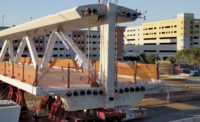The Florida International University Tragedy
How Berger’s Peer Review Role Figures In Potential Bridge Collapse Settlement

The north end of the FIU pedestrian bridge, several days before the collapse. Image courtesy of OSHA
As negotiations near a conclusion for a settlement with victims of last year’s fatal Florida International University bridge collapse, the role of the Louis Berger Group as peer review consultant is proving crucial. Attorneys for families of the six people who were killed and survivors say Berger is the last defendant that has not agreed to terms in lawsuits in state court in Miami against the companies that designed and built the bridge.
As a peer review consultant, Berger's position was different. The firm, acquired by Montreal-based design giant WSP Global last year, didn't take credit for the creative design work. It wasn't a major player in the dramatic events preceding the disaster. It hadn't been involved with the job for months.
Berger’s peer review included only final design and not intermediate phases during construction, according to a report by the U.S. Occupational Safety & Health Administration published in June. The structure collapsed before important final connections had been completed.
Peer review certificates required by the Florida Dept. of Transportation ask the peer review firm to include "constructability" and "compatibility of construction phasing with Traffic Control."
Had Berger checked construction conditions, the tragedy could have been averted, OSHA claimed.
Peer review certificates required by the Florida Dept. of Transportation ask the peer review firm to include “constructability” and “compatibility of construction phasing with Traffic Control.” The certificates do not include the words interim phases of construction or construction loads.
The certificates do state that Berger’s work complied with contract documents and FDOT's plans manual. And that may have been enough to create liability, although not as great as that of the engineer of record and prime contractor.
Insurers for Munilla Construction Management (MCM)—now Magnum Construction Management—agreed in late April to contribute $42 million to a settlement fund. The insurers involved are Greenwich Insurance Co., Indian Harbor Insurance Co. and XL Insurance America, all part of AXA XL, and the The Ohio Casualty Insurance Co.,which is part of Liberty Mutual.
Separately, FIGG Bridge Engineers, the project’s Tallahassee-based main designer, has also agreed to contribute to the settlement fund, as have more than 20 subcontractors, the Miami Herald reports.
To date, Berger Group has declined to comment on its role or on OSHA’s report, which spread criticism among FIGG Bridge Engineers, MCM, inspection contractor Bolton, Perez and state transportation officials.
OSHA was especially pointed in its criticism of FIGG, the engineer-of-record on the project, which has declined to admit to errors or respond directly to the criticism that its design lacked redundancy and that the company failed to act when alarming cracks appeared on the structure. FIGG has indicated that it would await the completion of the National Transportation Safety Board’s ongoing investigation and other reports for the truth of what happened to emerge.
Unusual Concrete Truss
The FIU campus borders Sweetwater, Fla, near Miami, where the pedestrian bridge was designed as an unusual concrete truss spanning a busy road at the campus' edge. It was constructed using the Accelerated Bridge Construction method, where the truss was created nearby and then slowly rolled to its final position over the road in early March, 2018. Important final connections had yet to be made. Temporary support had been removed and traffic was active on the road beneath the structure when it collapsed on the morning of March 15.
In the days prior to the collapse, the project team struggled with worsening cracks. A subcontractor was re-tensioning a bar in part of the truss to try to address the cracking problem at the time of the collapse. Other measures, including shims, were also tried.
Berger’s role in the tragedy is less central than that of FIGG or MCM, which were present on the day the bridge collapsed, killing six people and injuring others. W. Denney Pate, FIGG’s lead on the project, led a meeting the morning of the tragedy re-assuring all project team members that there was "no safety concern" despite deep and wide cracks on part of the structure.
Berger had finished its work on the project long before, when the company had assigned a single engineer to carry out the peer review.
Under Berger’s scope, the company’s peer review work included developing a finite element model for the bridge and its foundation, substructure and superstructure and its components under different loading conditions.
Peer Review Certificate Submitted
Whether Berger should have known what the OSHA report says, that state rules require peer review of all phases of work as well as final design, isn’t clear.
In certificates of peer review required by FDOT, peer reviewers attest to the fact that the review of the final design was made “pursuant to the requirements of the Contract documents” in accordance with Chapter 26 of the Plans Preparation Manual and all other governing regulations. While the words interim phases of construction aren't used, other language in the plans manual seems to imply that the peer review should be comprehensive.
Nevertheless, OSHA investigators wrote that, “If Louis Berger had checked the design at Stage 3, it could have discovered structural deficiencies in the design, and this incident could have been prevented....an opportunity was missed. Louis Berger and FIGG did not comply with the intent and meaning of the FDOT provisions of the peer review.”
OSHA investigators said that the Berger engineer who did the peer review told them the scope was limited by the small fee paid. The OSHA investigators accepted the statement but raised new questions.
“It is interesting to note that neither FIGG, FIU nor FDOT raised the issue of why the structural design of the intermediate stage was not checked by Louis Berger,” the OSHA investigation stated. “FIU and FDOT may not have known that the intermediate stages of construction were not checked by Louis Berger, but FIGG knew because Louis Berger created the scope of work based on the limited resources allocated by FIGG.”
Yet even OSHA's dissection of the scope and fee issue leaves other questions unanswered, especially given the huge legal exposure a design firm assumes in a peer review. Unlike U.S. physicians, who enjoy legal immunity for most peer reviews under state laws, engineers have no similar privilege except in Missouri and Kansas. The National Association of Professional Engineers has supported such immunity laws since 2017.
Lacking immunity, judicious use of words can help.
Attorney Kenneth E. Rubinstein says that there are ways a peer review engineer can state that its work was limited in nature. "You could say load calculations all appear to be accurate but you could also say you have not examined the underlying foundations and assume it will be poured to the appropriate depth. What is standard is to call that out. To say outright that the underlying work was never verified."
Using the excuse that all the phases of construction were never verified would be a difficult argument to maintain, adds Rubinstein, who is a director in the Boston and Concord, N.H., offices of Preti, Flaherty, "And saying that the fee was small would work against you," he adds.
The Berger structural engineer who conducted the peer review told OSHA investigators that four months after the completion of the peer review, he was no longer working at the company for reasons unrelated to the project.
OSHA’s investigation report stated that Berger declined to turn over its emails with FIGG Bridge Engineers, a decision OSHA termed “regrettable.”
Stuart Grossman, an attorney representing Richard Humble, who was an SUV passenger beneath the bridge and was injured when it collapsed, said the reasons for not conducting a more complete peer review of the unusual structure remain unknown.
"If they felt there was a need for further inspections, they certainly never spoke up," he says. "As a result, it gave everybody a false sense of safety."
--with Scott Judy




